One Riven puzzle considered
Monday, July 8, 2024
Comments: 4 (latest 4 days later)
Tagged: riven, myst, cyan, ruminations, design, puzzles
In my Riven comments, I said that I didn't like the way one bit of a puzzle plays out. That discussion was too deep a dive for the review post, so I'm breaking it out here. Flippers up!
This is a full-on SPOILER discussion of one particular Riven puzzle. Stop here if you intend to play the game.
Okay, we're talking about the fire-marble puzzle. This is of course one of the two roof-beam puzzles of the game, the puzzles that everything else hangs off. You could reasonably call it a meta-puzzle: you need to work out several distinct information puzzles and then put that information together in the waffle grid.
As I said, I'm happy with all of that. I know the 1997 waffle grid has its partisans, but I think the new puzzle structure works fine.
(Does everybody call that the "waffle grid", by the way? The name is ubiquitous in Myst fandom but I have no idea how far it's spread.)
Anyhow, I'm not going to talk about the waffle grid part of the puzzle at all. This post is about an earlier stage: the part where you enter each spinny dome and charge up a fire-marble. Specifically, this device:
The in-character goal here, the "Watsonian" goal, is to light up one marble from the stock and fire it off to the Gold Dome. Each dome has a specific frequency (handwave handwave), which gives the marble a specific color. When all five colored marbles are at the Gold Dome, you can power the waffle grid. This is explained in Gehn's diary somewhere.
The design goal, the Watsonian goal, is to make the player visit each dome (thus gating progress on fully exploring Riven) and also unlock it (thus securing the symbol-to-island information puzzle). As a bonus, this lets them connect up the fast-travel Starry Expanse catwalks. Also it gets them to hang out in the Expanse, which is an awesome environment and deserves some hang time.
(My terminology obviously refers to "Richard A. Watson", the fictional character in Uru and Myst 5, versus Richard A. Watson, the development lead and loremaster for the original Riven game. I hope these useful terms come into wider use in Myst fandom. But let us continue.)
The problem is that this process is not transparent to the player. You click on the handle a few times, push the glowing button, there's some kind of light show, you hear a FLOOSH noise, and you're done. The marble is only briefly visible.
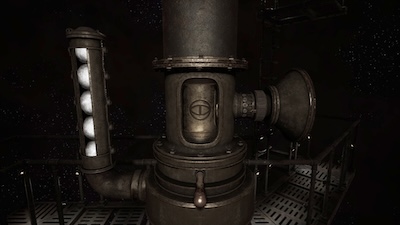
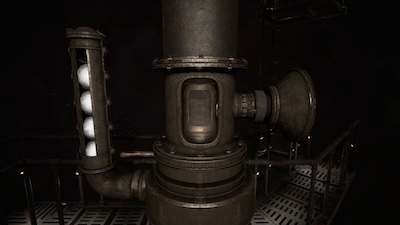
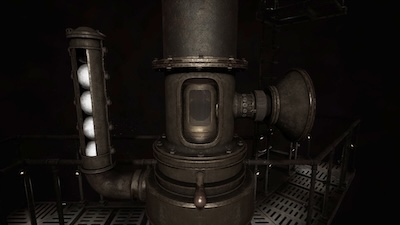

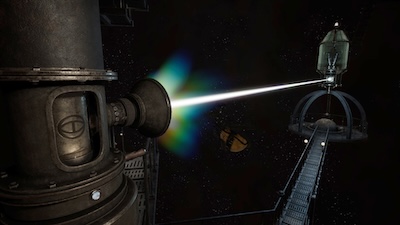
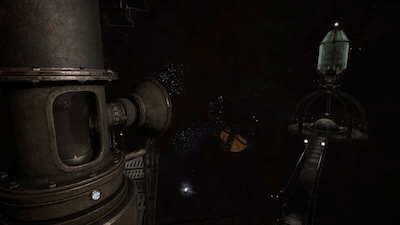 Completing the device puzzle. Note that the light beam is shooting into the device.
(There should be a white marble floating in the cylinder in step 3. I don't know why it didn't come out in the screenshot.)
Completing the device puzzle. Note that the light beam is shooting into the device.
(There should be a white marble floating in the cylinder in step 3. I don't know why it didn't come out in the screenshot.)
What happened? Is the puzzle solved? It must be solved, because the machine has stopped working.
But nothing really leads you to realize what just happened, if you don't remember Gehn's notebook. (Which you might not have even found at this point!)
You didn't see the marble charge up; you didn't see the marble leave town. (You can observe that the pneumatic cylinder flies out of the chamber, but this is very hard to notice. I didn't notice until I started taking screenshots for this post.) When you later return to the Gold Dome, you don't see that the marble has arrived. There are five indicator lights that show which marbles you've done, but the only connection to the Expanse devices are the pneumatic pipes that run out to the spinny domes.
(Which isn't nothing! Following physical pipes is a big part of the Myst puzzle aesthetic. But the connection between the FLOOSH noise and an item invisibly moving through the pipe is a bit indirect.)
Is this a design problem? You've done what's necessary, after all. Stumbling through a puzzle is still solving it.
But this gets back to my "crossword" comment. It is very often the case that solving a puzzle gives you a better perspective on the plot. "Oh, that's what that's for!" In a complex game like Riven, you might approach a sequence of puzzles from either end: the story clues you how to solve a puzzle, the puzzle clues you about the story. (Across clues down, down clues across.)
If you don't know what you just did, the puzzle fails to illuminate the story.
"I don't know what I did, I just clicked on it randomly" is a pretty common problem in this genre. But Cyan is usually good at avoiding it. What happened here?
My take is that the machine is too self-operating. You don't need a mental model of what it's doing. You don't feel how it works. You just need to click four times.
("Feel" is my own interpretation, I admit. If you believe that people learn via different sensory modalities, mine is tactile. Writing software is a sculptural process for me; code fits together.)
We might address this by making the machine more directly manipulatable. Say you have to manually align the pipe one way to pick up the marble, and then another way to expose it to the light beam, then a third way to shoot it up. Then you would have to think more about what you were doing.
This seems counterintuitive. We're adding more ways to fail. (Misalign the pipe, nothing happens.) In some sense, we're making the puzzle harder. Is that an improvment?
Well, we don't have to make it much harder. We can expose all the state changes to the player. (You can see the marble move. You can see a valve open once the marble is lit up. Etc.) You could still stumble through the puzzle, but now watching the steps helps you figure out what you're doing. (Lighting up the marble opens the exit valve, ergo it's time to use the exit pipe.) It's the crossword effect in miniature.
Plus, with a bit of clever, you could make it a five-way rotating mechanism. A thematic echo of the Beetle Room! What's not to love?
But this brings up the second problem, which is visual rather than tactile. To wit: the game can't show the marble at any time after you light it up.
This is because the marbles glow in different colors, and the colors are a separate information puzzle. You're supposed to get the color-to-island mapping from the underwater chamber, and the island-to-symbol mapping from the domes. If you could see the marble colors directly from the domes, you'd short-circuit the puzzle.
The game tries to work around this by putting the marble in an (opaque) pneumatic cylinder. You can see the cylinder move. But, as I said, you only see it move briefly and it's easy to miss. And we're still hiding the basic interaction of "irradiate marble, marble starts glowing", which is supposed to be the whole point of the process.
It's worth considering the idea of just allowing you to see the marble color at this point. Clues don't have to be unique! It would be fine, for example, if you could pick up the D'ni number system in a couple of places around the islands. Generous cluing can break up the feeling of linear exploration. It also reduces the chance that you'll get blocked by overlooking just one piece of paper.
However, in this case, the underwater chamber is a major set piece. We really don't want you to miss it. Also, it can be really bad for a clue to only appear briefly and then fly off. What if you fail to write it down? "Meh," the designer says, "you'll find the alternate color clue in the underwater chamber..." But you (the player) don't know that! If you think you've missed a once-only clue, you'll lose faith in the game.
So, short of completely redesigning the color/island/symbol information puzzle, we're stuck with the restriction of hiding the marble color.
Here's an idea I'm tossing around: keep the marble visible at all times. When you irradiate it, the marble starts glowing with a shifting multicolored light. (Like the lens radiance in the screenshot above.) When you get to the Gold Dome, you can see the marbles but they're still multicolored. When you activate the waffle grid mechanism, then the marbles settle down to their five solid colors. (Triggered by a flashbulb, perhaps.) The mechanism already obscures which marble came from which dome, so that part is okay.
(Maybe this is inconsistent with how fire marbles work in Uru or in the books -- I haven't read all the books. I don't care though. Cyan is happy to handwave continuity unless it's more fun to stick to it.)
All of this points up the general awkwardness of the color-to-symbol puzzle. Those color symbols appear quite a bit -- including places where it would be natural to see the colors!
If Gehn is scribbling notes on his lab bench, sure, he'll write down "red" and "blue" in shorthand. But the spinny domes? Those are significant landmarks which are built and labelled to represent different colors. Meaningfully different colors, not arbitrary colors. (Each one has a specific marble irradiation frequency.) They're also a rapid-transit system! It's hard to imagine that someone would build a Blue Line stop that also turns your ticket blue and not put a big blue sign on it.
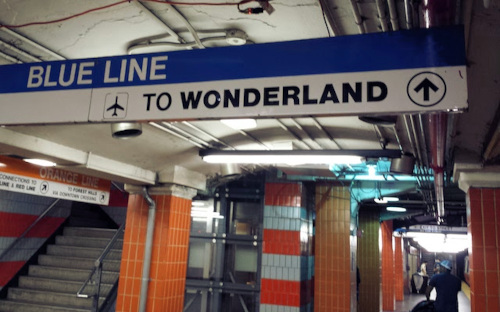 Anyone got a nickel for Charlie?
Anyone got a nickel for Charlie?
Maybe it's time to think about redesigning the color/island/symbol information puzzle after all. But let's leave that as an exercise for the (very patient) reader.
Comments from Mastodon
@zarfeblong The lore suggests Gehn is color blind and the symbols are the important bits 😼
Also, more seriously this does seem like one of the puzzles that more than usual breaks from the change in camera behavior (from “cutscene controlled” to player controlled) and probably could have used a further revision pass in this version
@zarfeblong Good write-up! I did not understand how I solved the puzzle in my own Riven 2024 playthrough, until I read your analysis. There’s definitely something off.
(And now I’m thinking about how I myself would change the puzzle to be more understandable.)
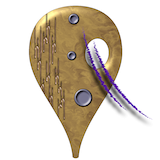

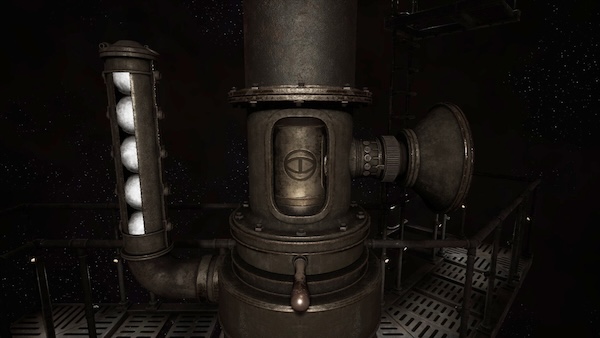
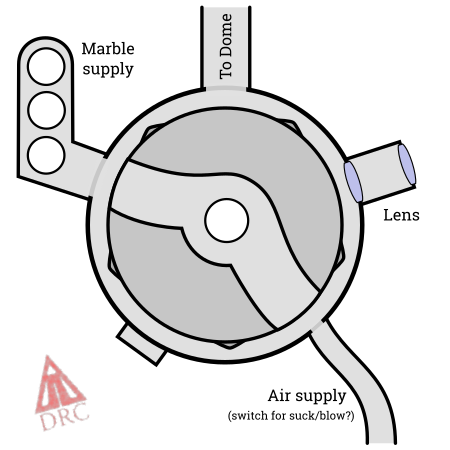
@zarfeblong that bit about the “watsonian” perspective is brilliant